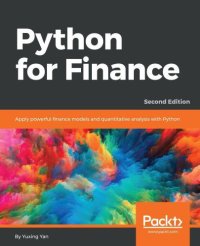
Ebook: Python for Finance
Author: Yan Yuxing
- Tags: Big data, Finance--Data processing, Python, Electronic books, Finance -- Data processing
- Year: 2017
- Publisher: Packt Publishing
- City: Birmingham
- Edition: 2nd edition
- Language: English
- mobi
Cover -- Copyright -- Credits -- About the Author -- About the Reviewers -- www.PacktPub.com -- Customer Feedback -- Table of Contents -- Preface -- Chapter 1: Python Basics -- Python installation -- Installation of Python via Anaconda -- Launching Python via Spyder -- Direct installation of Python -- Variable assignment, empty space, and writing our own programs -- Writing a Python function -- Python loops -- Python loops, if...else conditions -- Data input -- Data manipulation -- Data output -- Exercises -- Summary -- Chapter 2: Introduction to Python Modules -- What is a Python module? -- Introduction to NumPy -- Introduction to SciPy -- Introduction to matplotlib -- How to install matplotlib -- Several graphical presentations using matplotlib -- Introduction to statsmodels -- Introduction to pandas -- Python modules related to finance -- Introduction to the pandas_reader module -- Two financial calculators -- How to install a Python module -- Module dependency -- Exercises -- Summary -- Chapter 3: Time Value of Money -- Introduction to time value of money -- Writing a financial calculator in Python -- Definition of NPV and NPV rule -- Definition of IRR and IRR rule -- Definition of payback period and payback period rule -- Writing your own financial calculator in Python -- Two general formulae for many functions -- Appendix A -- Installation of Python, NumPy, and SciPy -- Appendix B -- visual presentation of time value of money -- Appendix C -- Derivation of present value of annuity from present value of one future cash flow and present value of perpetuity -- Appendix D -- How to download a free financial calculator written in Python -- Appendix E -- The graphical presentation of the relationship between NPV and R -- Appendix F -- graphical presentation of NPV profile with two IRRs -- Appendix G -- Writing your own financial calculator in Python.;Learn and implement various Quantitative Finance concepts using the popular Python librariesAbout This Book* Understand the fundamentals of Python data structures and work with time-series data* Implement key concepts in quantitative finance using popular Python libraries such as NumPy, SciPy, and matplotlib* A step-by-step tutorial packed with many Python programs that will help you learn how to apply Python to financeWho This Book Is ForThis book assumes that the readers have some basic knowledge related to Python. However, he/she has no knowledge of quantitative finance. In addition, he/she has no knowledge about financial data. What You Will Learn* Become acquainted with Python in the first two chapters* Run CAPM, Fama-French 3-factor, and Fama-French-Carhart 4-factor models* Learn how to price a call, put, and several exotic options* Understand Monte Carlo simulation, how to write a Python program to replicate the Black-Scholes-Merton options model, and how to price a few exotic options* Understand the concept of volatility and how to test the hypothesis that volatility changes over the years* Understand the ARCH and GARCH processes and how to write related Python programsIn DetailThis book uses Python as its computational tool. Since Python is free, any school or organization can download and use it. This book is organized according to various finance subjects. In other words, the first edition focuses more on Python, while the second edition is truly trying to apply Python to finance. The book starts by explaining topics exclusively related to Python. Then we deal with critical parts of Python, explaining concepts such as time value of money stock and bond evaluations, capital asset pricing model, multi-factor models, time series analysis, portfolio theory, options and futures. This book will help us to learn or review the basics of quantitative finance and apply Python to solve various problems, such as estimating IBM's market risk, running a Fama-French 3-factor, 5-factor, or Fama-French-Carhart 4 factor model, estimating the VaR of a 5-stock portfolio, estimating the optimal portfolio, and constructing the efficient frontier for a 20-stock portfolio with real-world stock, and with Monte Carlo Simulation. Later, we will also learn how to replicate the famous Black-Scholes-Merton option model and how to price exotic options such as the average price call option. Style and approachThis book takes a step-by-step approach in explaining the libraries and modules in Python, and how they can be used to implement various aspects of quantitative finance. Each concept is explained in depth and supplemented with code examples for better understanding.
Download the book Python for Finance for free or read online
Continue reading on any device:

Last viewed books
Related books
{related-news}
Comments (0)